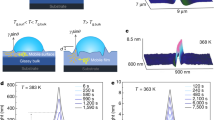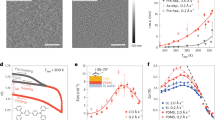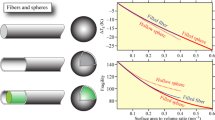Abstract
Despite the decade-long study of the effect of nanoconfinement on the glass-transition temperature (Tg) of amorphous materials, the quest to probe the distribution of Tgs in nanoconfined glass formers has remained unfulfilled. Here the distribution of Tgs across polystyrene films has been obtained by a fluorescence/multilayer method, revealing that the enhancement of dynamics at a surface affects Tg several tens of nanometres into the film. The extent to which dynamics smoothly transition from enhanced to bulk states depends strongly on nanoconfinement. When polymer films are sufficiently thin that a reduction in thickness leads to a reduction in overall Tg, the surface-layer Tg actually increases with a reduction in overall thickness, whereas the substrate-layer Tg decreases. These results indicate that the gradient in Tg dynamics is not abrupt, and that the size of a cooperatively rearranging region is much smaller than the distance over which interfacial effects propagate.
This is a preview of subscription content, access via your institution
Access options
Subscribe to this journal
Receive 12 print issues and online access
$259.00 per year
only $21.58 per issue
Buy this article
- Purchase on Springer Link
- Instant access to full article PDF
Prices may be subject to local taxes which are calculated during checkout





Similar content being viewed by others
References
Angell, C.A., Ngai, K.L., McKenna, G.B., McMillan, P.F. & Martin, S.W. Relaxation in glassforming liquids and amorphous solids. J. Appl. Phys. 88, 3113–3157 (2000).
Debenedetti, P.G. & Stillinger, F.H. Supercooled liquids and the glass transition. Nature 410, 259–267 (2001).
Sillescu, H. Heterogeneity at the glass transition: A review. J. Non-Cryst. Solids 243, 81–108 (1999).
Jackson, C.L. & McKenna, G.B. The glass transition of organic liquids confined to small pores. J. Non-Cryst. Solids 131, 221–224 (1991).
Reiter, G. Mobility of polymers in films thinner than their unperturbed size. Europhys. Lett. 23, 579–584 (1993).
Keddie, J.L., Jones, R.A.L. & Cory, R.A. Size-dependent depression of the glass transition temperature in polymer films. Europhys. Lett. 27, 59–64 (1994).
Forrest, J.A. & Dalnoki-Veress, K. The glass transition in thin polymer films. Adv. Coll. Interf. Sci. 94, 167–196 (2001).
Adam, G. & Gibbs, J.H. On temperature dependence of cooperative relaxation properties in glass-forming liquids. J. Chem. Phys. 43, 139–146 (1965).
Hempel, E., Hempel, H., Hensel, A., Schick, C. & Donth, E. Characteristic length of dynamic glass transition near Tg for a wide assortment of glass-forming substances. J. Phys. Chem. B 104, 2460–2466 (2000).
Reinsberg, S.A., Qui, X.H., Wilhelm, M., Spiess, H.W. & Ediger, M.D. Length scale of dynamic heterogeneity in supercooled glycerol near Tg . J. Chem. Phys. 114, 7299–7302 (2001).
Arndt, M., Stannarius, R., Groothues, H., Hempel, E. & Kremer, F. Length scale of cooperativity in the dynamic glass transition. Phys. Rev. Lett. 79, 2077–2080 (1997).
Barut, G., Pissis, P., Petster, R. & Nimtz, G. Glass transition in liquids: Two versus three-dimensional confinement. Phys. Rev. Lett. 80, 3543–3546 (1998).
Melnichenko, Y.B., Schuller, J., Richert, R., Ewen, B. & Long, C.K. Dynamics of hydrogen-bonded liquids confined to mesopores: A dielectric and neutron spectroscopy study. J. Chem. Phys. 103, 2016–2024 (1995).
Schonhals, A., Goering, H. & Schick, C. Segmental and chain dynamics of polymers: From the bulk to the confined state. J. Non-Cryst. Solids 305, 140–149 (2002).
Kawana, S. & Jones, R.A.L. Character of the glass transition in thin supported polymer films. Phys. Rev. E 63, 021501 (2001).
van Zanten, J.H., Wallace, W.E. & Wu, W.L. Effect of strongly favorable substrate interactions on the thermal properties of ultrathin polymer films. Phys. Rev. E 53, R2053–R2056 (1996).
Fukao, K. & Miyamoto, Y. Glass transitions and dynamics in thin polymer films: dielectric relaxation of thin films of polystyrene. Phys. Rev. E 61, 1743–1754 (2000).
Forrest, J.A., Dalnoki-Veress, K., Stevens, J.R. & Dutcher, J.R. Effect of free surfaces on the glass transition temperature of thin polymer films. Phys. Rev. Lett. 77, 2002–2005 (1996).
DeMaggio, G.B. et al. Interface and surface effects on the glass transition in thin polystyrene films. Phys. Rev. Lett. 78, 1524–1527 (1997).
Long, D. & Lequeux, F. Heterogeneous dynamics at the glass transition in van der Waals liquids, in the bulk and in thin films. Eur. Phys. J. E 4, 371–387 (2001).
de Gennes, P.G. Glass transitions in thin polymer films. Eur. Phys. J. E 2, 201–203 (2000).
Dalnoki-Veress, K., Forrest, J.A., de Gennes, P.G. & Dutcher, J.R. Glass transition reductions in thin freely-standing polymer films: A scaling analysis of chain confinement effects. J. Phys. IV 10, 221–226 (2000).
Forrest, J.A. & Mattsson, J. Reductions of the glass transition temperature in thin polymer films: probing the length scale of cooperative dynamics. Phys. Rev. E 61, R53–R56 (2000).
McCoy, J.D. & Curro, J.G. Conjectures on the glass transition of polymers in confined geometries. J. Chem. Phys. 116, 9154–9157 (2002).
Torres, J.A., Nealey, P.F. & de Pablo, J.J. Molecular simulation of ultrathin polymeric films near the glass transition. Phys. Rev. Lett. 85, 3221–3224 (2000).
Jones, R.A.L. Commentary to “Glass transitions in thin polymer films”. Eur.Phys. J. E 2, 205 (2000).
Hall, D.B., Underhill, P. & Torkelson, J.M. Spin coating of thin and ultrathin polymer films. Polym. Eng. Sci. 38, 2039–2045 (1998).
Frank, C.W. et al. Structure in thin and ultrathin spin-cast polymer films. Science 273, 912–915 (1996).
Hall, D.B., Hooker, J.C. & Torkelson, J.M. Ultrathin polymer films near the glass transition: Effect on the distribution of alpha-relaxation times as measured by second harmonic generation. Macromolecules 30, 667–669 (1997).
Schwab, A.D., Agra, D.M.G., Kim, J.H., Kumar, S. & Dhinojwala, A. Surface dynamics in rubbed polymer thin films probed with optical birefringence measurements. Macromolecules 33, 4903–4909 (2000).
Ellison, C.J., Hall, D.B., Kim, S.D. & Torkelson, J.M. Confinement and processing effects on glass transition temperature and physical aging in ultrathin polymer films: Novel fluorescence measurements. Eur. Phys. J. E 8, 155–165 (2002).
Ellison, C.J. & Torkelson, J.M. Sensing the glass transition in thin and ultrathin polymer films via fluorescence probes and labels. J. Polym. Sci. B 24, 2745–2758 (2002).
Bell, R.C., Wang, H., Iedema, M.J. & Cowin, J.P. Nanometre-resolved interfacial fluidity. J. Am. Chem. Soc. 125, 5176–5185 (2003).
Deschenes, L.A. & Vanden Bout, D.A. Single-molecule studies of heterogeneous dynamics in polymer melts near the glass transition. Science 292, 255–258 (2001).
Quirin, J.C., Bartko, A.C., Dickson, R.M. & Torkelson, J.M. Signature of nanoscale dynamic heterogeneity in polymers near the glass transition: Non-gaussian displacement distribution from single-molecule probe diffusion studies. Polym. Preprints 42(2), 174–175 (2001).
Deppe, D.D., Dhinojwala, A. & Torkelson, J.M. Small molecule probe diffusion in thin polymer films near the glass transition: A novel approach using fluorescence nonradiative energy transfer. Macromolecules 29, 3898–3908 (1996).
Hall, D.B., Dhinojwala, A. & Torkelson, J.M. Translation-rotation paradox for diffusion in glass-forming polymers: The role of the temperature dependence of the relaxation times distribution. Phys. Rev. Lett. 79, 103–106 (1997).
Whitlow, S.J. & Wool, R.P. Diffusion of polymers at interfaces – a secondary ion mass-spectroscopy study. Macromolecules 24, 5926–5938 (1991).
Frank, B., Gast, A.P., Russell, T.P., Brown, H.R. & Hawker, C. Polymer mobility in thin films. Macromolecules 29, 6531–6534 (1996).
X. Zheng et al. Long-range effects on polymer diffusion induced by a bounding interface. Phys. Rev. Lett. 79, 241–244 (1997).
Jean, Y.C. et al. Glass transition of polystyrene near the surface studied by slow-positron-annihilation spectroscopy. Phys. Rev. B 56, R8459–R8462 (1997).
Agra, D.M.G., Schwab, A.D., Kim, J.H., Kumar, S. & Dhinojwala, A. Relaxation dynamics of rubbed polystyrene thin films. Europhys. Lett. 51, 655–660 (2000).
Wallace, W.E., Fischer, D.A., Efimenko, K., Wu, W.L. & Genzer, J. Polymer chain relaxation: Surface outpaces bulk. Macromolecules 34, 5081–5082 (2001).
Liu, Y. et al. Surface relaxations in polymers. Macromolecules 30, 7768–7771 (1997).
Glotzer, S.C. Spatially heterogeneous dynamics in liquids: insights from simulation. J. Non-Cryst. Solids 274, 342–355 (2000).
Weeks, E.R., Crocker, J.C., Levitt, A.C., Schofield, A. & Weitz, D.A. Three-dimensional imaging of structural relaxation near the colloidal glass transition. Science 287, 627–631 (2000).
Yu, C.J., Richter, A.G., Datta, A., Durbin, M.K. & Dutta, P. Observation of molecular layering in thin liquid films using x-ray reflectivity. Phys. Rev. Lett. 82, 2336–2329 (1999).
Russel, E.V. & Israeloff, N.E. Direct observation of molecular cooperativity near the glass transition. Nature 408, 695–698 (2000).
Author information
Authors and Affiliations
Corresponding author
Ethics declarations
Competing interests
The authors declare no competing financial interests.
Rights and permissions
About this article
Cite this article
Ellison, C., Torkelson, J. The distribution of glass-transition temperatures in nanoscopically confined glass formers. Nature Mater 2, 695–700 (2003). https://doi.org/10.1038/nmat980
Received:
Accepted:
Published:
Issue Date:
DOI: https://doi.org/10.1038/nmat980
This article is cited by
-
Conformation-Induced stiffening effect of crosslinked polymer thin films
Communications Physics (2023)
-
Unraveling bilayer interfacial features and their effects in polar polymer nanocomposites
Nature Communications (2023)
-
Alternating chain sequence weakening of interfacial molecular interactions enhances the Tg confinement effect of polymers
Polymer Journal (2022)
-
Thermal stabilities of a molecularly stepped PMMA substrate prepared by thermal nanoimprinting and isolated PMMA chains deposited on it evaluated by high-temperature atomic force microscopy
Polymer Journal (2021)
-
SMART transfer method to directly compare the mechanical response of water-supported and free-standing ultrathin polymeric films
Nature Communications (2021)



